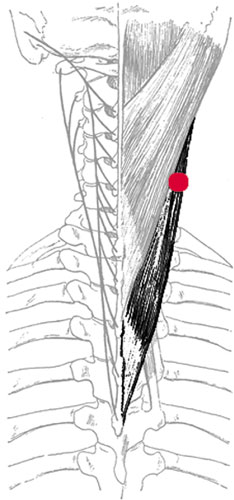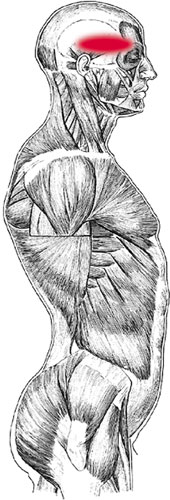Trigger Point Therapy for Myofascial Pain (10 page)
Read Trigger Point Therapy for Myofascial Pain Online
Authors: L.M.T. L.Ac. Donna Finando


Splenius cervicis and trigger point


Splenius cervicis pain pattern
S
PLENIUS
C
ERVICIS
Proximal attachment:
Posterior tubercles of the transverse processes of C1âC3.
Distal attachment:
Spinous processes of T3âT6.
Action:
Acting unilaterally:
rotation and sidebending of the neck.
Acting bilaterally:
extension of the neck.
Palpation:
To locate splenius cervicis, identify the following structures:
- TrapeziusâSee muscle description on page 59.
- Levator scapulaeâSee muscle description on page 63.
To palpate splenius cervicis, place your patient in the seated position with his back resting comfortably on the back of the chair. Laterally bend the patient's head slightly to the side being palpated, thereby relaxing both the trapezius and the levator scapulae. Palpate with one or two fingers on the vertical plane that exists between the trapezius and the levator scapulae, moving the trapezius posteromedially and the levator scapulae anterolaterally. Gently rotate the patient's head slightly to the opposite side. Palpate taut bands vertically within the defined space.
Pain pattern:
Pain in the neck, cranium, and eye; patient may experience stiff neck associated with the pain. Upper trigger point causes aching pain through the head to the back of the eye on the same side, with a possible blurring of vision in that eye. Lower trigger point causes pain radiating upward and to the base of the neck.
Causative or perpetuating factors:
Postural stresses that overload, such as thrusting the head forward to compensate for excessive thoracic kyphosis.
Satellite trigger points:
Levator scapulae, upper trapezius, sternocleidomastoid, splenius capitis.
Affected organ system:
Vision.
Associated zones, meridians, and points:
Dorsal zone; Foot Tai Yang Bladder meridian.
Stretch exercise:
Drop the head forward, rotating the neck 30 to 40 degrees to the side. Gently press the head down, more forward than lateral. The muscle on the opposite side will be stretched.
Strengthening exercise:
Isometric against mild posterior resistance. Clasp the hands behind the head at the level of the nuchal line. Direct the patient to press the head and neck posteriorly against the mild resistance provided by the clasped hands.

Stretch exercise: Splenius cervicis

Posterior cervicals and trigger points
P
OSTERIOR
C
ERVICALS
S
EMISPINALIS
C
APITIS
AND
S
EMISPINALIS
C
ERVICIS
Proximal attachment:
Semispinalis capitis:
on the occiput between the superior and inferior nuchal lines.
Semispinalis cervicis:
spinous processes of C2âC5.
Distal attachment:
Semispinalis capitis:
transverse processes of T1âT6; articular processes of C3âC7.
Semispinalis cervicis:
transverse processes of T1âT6.
Action:
Acting unilaterally:
slight rotation of the neck to the contralateral side (semispinalis cervicis) and slight rotation of the head and neck to the same side (semispinalis capitis).
Acting bilaterally:
extension of the neck (semispinalis cervicis) and extension of the head and neck (semispinalis capitis).
Palpation:
Semispinalis capitis is considered to be one of the most powerful muscles of the neck. Palpate the posterior cervicals simultaneously. Semispinalis cervicis lies deep to semispinalis capitis.
To locate the the posterior cervicals, identify the following structures:
- OcciputâThe base of the skull
- Spinous processes of C2âC5
Palpate semispinalis capitis through the superficial musculature of the neck. With the patient lying supine, locate the base of the occiput, supporting it with the palms of your hands. Palpate with the pads of the second, third, and fourth fingers, moving distally from the occiput toward the lower cervical region. Place your hands with your fingers lying in the direction of the long fibers of the muscles, adjacent to the spinous processes of the cervical vertebrae. Your fingers will be covering the region under which semispinalis capitis lies beneath the more superficial trapezius and splenius muscles. Deep, flat palpation will note thickened areas of muscle approximately 2 centimeters ( inch) wide. Constrictions may be noted approximately 1 to 2 inches below the occiput and at the level of C4â5.
inch) wide. Constrictions may be noted approximately 1 to 2 inches below the occiput and at the level of C4â5.

Semispinalis capitis

Semispinalis cervicis
Posterior cervicals pain pattern
Pain pattern:
Proximal trigger point refers pain that encircles the head, reaching its maximum intensity at the temple and forehead over the eye. Intermediate trigger point refers pain over the occiput and toward the vertex. Distal trigger point (C4â5 area) refers pain and tenderness to the suboccipital region and down over the neck and upper part of the shoulder girdle. Symptoms include pain in the neck; restriction of head and neck flexion, with possibly some restriction of head and neck rotation and extension; and tenderness at the back of the head and neck.
Causative or perpetuating factors:
Sustained flexion of the neck (semispinalis cervicis) and of the neck and head (semispinalis capitis); sustained extension of the neck and head.
Satellite trigger points:
Bilateral posterior cervical muscles.
Affected organ system:
Vision.
Associated zones, meridians, and points:
Dorsal zone; Foot Tai Yang Bladder meridian; BL 10â17.
Stretch exercise:
Drop the head forward, aiming the chin for the chest. Allow the weight of the head, acting with gravity, to stretch the posterior neck muscles. In doing so the chin will reach the lowest possible level on the chest. It is important to try to avoid pulling the chin in toward the throat during this stretch.
Strengthening exercise:
Isometric against mild posterior resistance. Clasp the hands behind the head at the level of the nuchal line. Press the head and neck posteriorly against the mild resistance provided by the clasped hands.